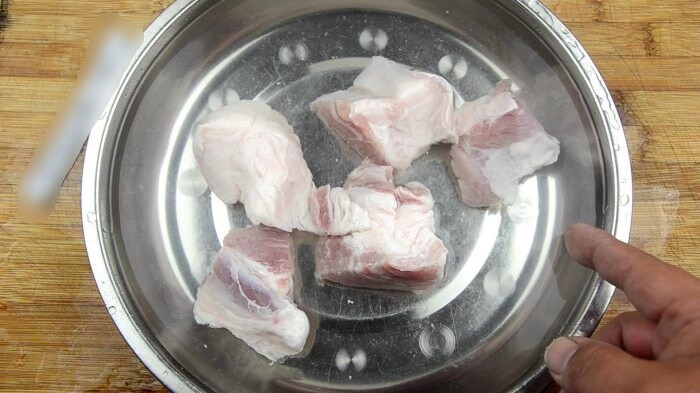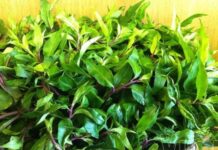
Surprisingly, you only need two common kitchen ingredients: salt and white vinegar.
Method:
– Prepare the meat and ingredients: Place the pork in a large bowl or container, add a small amount of water to moisten its surface, and then evenly sprinkle a pinch of coarse salt on top. Salt accelerates the thawing process and helps tenderize the meat faster.

– Add white vinegar: Next, drizzle a bit of white vinegar over the meat. Vinegar not only eliminates any gamey odor but also tenderizes the fibers and kills surface bacteria.
– Soak in cold water: Pour in cold water until the meat is fully submerged, avoiding hot water. After about 10 minutes, you’ll notice the meat beginning to soften.
Why avoid hot water for thawing?
According to chefs, hot water causes the meat’s exterior to “cook” rapidly, darkening and losing moisture while the interior remains frozen. This temperature disparity not only diminishes flavor but also fosters bacterial growth, compromising food safety. Prolonged exposure to hot water can also deplete the meat’s nutritional value.
Complete the thawing process:
After 10 minutes, remove the meat and gently press it; only the center should feel slightly firm. At this point, cut the meat into smaller pieces and soak for an additional 2 minutes in clean water.

Once fully tenderized, rinse the meat one last time before cooking. This method ensures quick thawing while preserving the meat’s vibrant color, natural sweetness, and freshness, unaffected by salt or vinegar. It also removes excess blood, leaving the meat cleaner and safer.
Notes:
A 10-minute soak is ideal for 200–300g portions. For larger pieces, divide the meat before freezing to simplify thawing and usage.
When storing, portion the meat into meal-sized bags to expedite thawing and minimize waste.
With just salt and white vinegar, you can efficiently thaw meat in minutes while retaining its delicious flavor—a simple yet invaluable tip for busy individuals who prioritize family meals.
“The Ultimate Guide to Buying Bun: How to Spot the Difference Between Clean and Chemical-Laden Noodles”
“The addition of harmful substances such as borax, fluorescent agents, and preservatives is a common practice in bun production. These additives are used to enhance the texture and appearance of the noodles, making them chewier and brighter in color, and extending their shelf life. However, these chemicals pose a significant risk to consumers’ health, and it is important to be aware of their presence and potential dangers.”
The 12 Fruits and Vegetables with the Highest Pesticide Residues in 2025: A Shopping Awareness Guide for the Health-Conscious Shopper.
Are you aware that not all produce that looks fresh and appealing at the market or grocery store is actually safe? In 2025, the United States released a list of the 12 types of fruits and vegetables with the highest pesticide residues. Read on to learn more and make smarter choices to protect your family’s health!






































